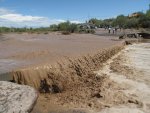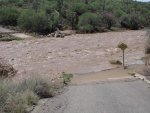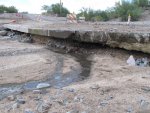CaveCreekRay
Well-known member
Lifetime Member
Equipment
L3800 HST, KingKutter box scraper, KingKutter 66" rake, County Pride Subsoiler
Three tractors:
Tractor One Air-only tires. No additional weight on machine other than implements
This would be the worst case. Compressed air is denser than uncompressed air but the tires would still offer some negligible buoyancy in the water. A filled tire will float, but just barely. (An inner tube inflated to only 5 lbs generates much more buoyancy. Remember, it all has to do with density and water displacement.) This would be the lightest tractor.
Tractor Two Water-filled tires, no additional weights other than implements.
This would be the middle-weight tractor because the only additional weight would be the weight of the water in the tires above the water line. Remember, if you fill a tire with water, it will slowly sink.
Tractor Three Air-only tires with implement -PLUS addition weight amounting to the weight of the water that would fill the rear tires -mounted above the waterline.
This would be the heaviest vehicle because you would not suffer the loss of the weight of the submerged ballast water in the tires. All the weight would be on the tires.
I cannot follow your second question... Sorry.
Ray
Tractor One Air-only tires. No additional weight on machine other than implements
This would be the worst case. Compressed air is denser than uncompressed air but the tires would still offer some negligible buoyancy in the water. A filled tire will float, but just barely. (An inner tube inflated to only 5 lbs generates much more buoyancy. Remember, it all has to do with density and water displacement.) This would be the lightest tractor.
Tractor Two Water-filled tires, no additional weights other than implements.
This would be the middle-weight tractor because the only additional weight would be the weight of the water in the tires above the water line. Remember, if you fill a tire with water, it will slowly sink.
Tractor Three Air-only tires with implement -PLUS addition weight amounting to the weight of the water that would fill the rear tires -mounted above the waterline.
This would be the heaviest vehicle because you would not suffer the loss of the weight of the submerged ballast water in the tires. All the weight would be on the tires.
I cannot follow your second question... Sorry.
Ray




